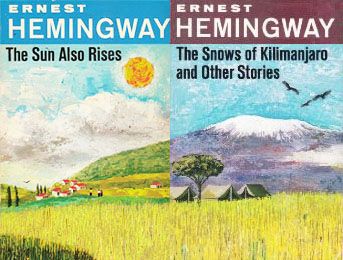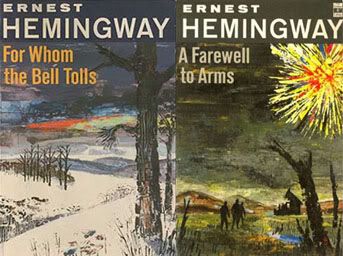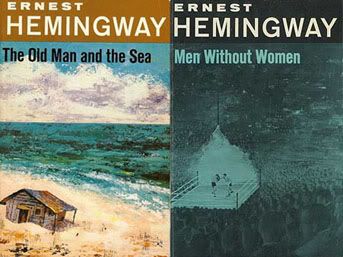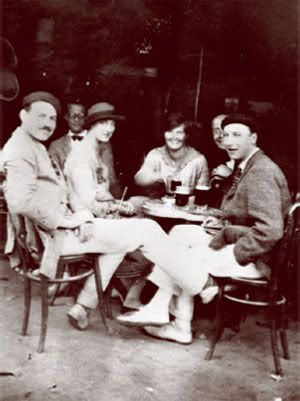Cover illustrations by James and Ruth McCrea
Summer is a time when I do most of my fiction reading now. Below is an unpublished blog I did on Ernest Hemingway a couple of years ago. I don't know why I didn't post it, except that I was hoping to do more of a literary critique of his books, and especially of
The Sun Also Rises, which I recently started to re-read, marking the pages that affected me.
The Sun Also Rises was one of my favorite books when I was in university - in graduate school to be exact - when I was was studying endless scientific research papers to fine tune my thesis. I would read just a few pages of the lovely script before embarking on journal articles. If I read too much, that would be the end of my "serious" studies, and I would spend the rest of the time on the book.
Here's what I wrote in my unpublished blog:
Summer Reading
Hemingway was a favorite of mine, back when I used to carry fiction books with me wherever I went. I don't do that as much now, but I do keep up with my fiction reading. I’m often re-reading older classics. Jane Austen's Emma and Tolstoy's Anna Karenina are perennial favorites. Contemporary fiction writers leave me unsatisfied. I can see their talent (of the talented ones, that is), but their stories are imbued with their personalities, as though they cannot shake off their egos as they write. Their stories also have macabre, strange, or nihilistic endings, and I come away bewildered or depressed.
Cover illustrations by James and Ruth McCrea
I've read four of Hemingway’s books: The Sun Also Rises, A Farewell to Arms, The Old Man and the Sea and For Whom the Bell Tolls. And his collection of short stories: The Snows of Kilimanjaro and Other Stories and Men Without Women. I'm not a literary critic, so I don't really know how to start analyzing Hemingway's writing - it's already been done ad infinitum anyway by experts and laymen alike. But, his stories are accounts of unrequited love in many ways. The characters, which he brings to life so clearly, are very modern people who enter all kinds of debacles, yet they come out surprisingly pure and unblemished despite their weaknesses and failures.
Tyrone Power, Ava Gardner and Eroll Flynn
in a 1957 film adaptation of The Sun Also Rises
Directed by Henry King
King also directed Ava Gardner in 1952 in
The Snows of Kilimanjaro, another Hemingway adaptation
Cover illustrations by James and Ruth McCrea
What surprised me reading Hemingway this time around are the long, unending sentences that Hemingway uses at times, producing an almost trance-like meditative quality. This goes against the hard simplicity of his prose that many analysts have described about his writing. His description of places, whether it is a café in Paris or the Spanish (and Italian) countryside resonates in my mind – always has – and urges me to visit these vivid locales.
[End of original (unpublished) blog entry.]
Here's an excerpt from
The Sun Also Rises as Jake Barnes, who is the narrator and protagonist, describes their entry into Spain:
Then we crossed a wide plain, and there was a big river off on the right shining in the sun from between the line of trees, and away off you could see the plateau of Pamplona rising out of the plain, and the walls of the city, and the great brown cathedral, and the broken skyline of the other churches. In the back of the plateau were the mountains, and every way you looked there were other mountains, and ahead the road stretched out white across the plain going toward Pamplona.
[Hemingway, Ernest. The Sun also Rises. New York: Charles Scribner's Sons, 1954. pp. 93-93]
But looking at the stamp in my (worn)
The Sun Also Rises, I find this:
Paper Back Junction
343 East Main Street
Lock Haven, PA 17745
So I was a fan of Hemingway even as an undergraduate in the small Pennsylvania college where I was a busy biology student!
The first pages of the book has these two quotes:
"You are all a lost generation"
- Gertrude Stein in conversation
- "One generation passeth away, and another generation cometh; but the earth abideth for ever...The sun also ariseth, and the sun goeth down, and hasteth to his place where he arose...The wind goeth toward the south, and turneth about unto the north; it whirleth about continually, and the wind returneth again according to his circuits...All the rivers run into the sea; yet the sea is not full; unto the place from whence the rivers come, thither they return again."
- Ecclesiastes
The nihilist, modernist, Stein is juxtaposed with a biblical account of the fullness, continuation and eternity of God's creations and of life. This odd, disconcerting juxtaposition is partly what makes
The Sun Also Rises a masterpiece: people never quite give up on life, and on love, despite the devastations many have been through.
Below is a photo of Hemingway in Pamplona in 1925, which I blogged about
here. Hemingway first edition of
The Sun Also Rises was published in 1926.
Left to right Ernest Hemingway with Lady Duff Twysden,
Hadley Hemingway, and three unidentified
people at a cafe in Pamplona, Spain, July 1925.
[Photograph in the Ernest Hemingway Photograph
Collection, John F. Kennedy Presidential Library
and Museum, Boston.]


















